Base General Bernardo O'Higgins Riquelme
Base General Bernardo O'Higgins Riquelme, also Base Libertador General Bernardo O'Higgins Riquelme, or shortly Bernardo O'Higgins, named after Bernardo O'Higgins, is a permanently staffed Chilean research station in Antarctica and the capital of Antártica Commune. It lies at 63°19′15″S 57°53′55″W, at an elevation of 13 m, about 30 km south-west of Prime Head, the northernmost point of the Antarctic Peninsula, at Cape Legoupil.
O'Higgins Station | |
|---|---|
| Base General Bernardo O'Higgins Riquelme | |
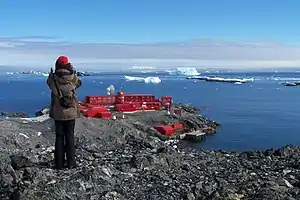 The Chilean base Bernardo O'Higgins Station | |
 O'Higgins Station Location of O'Higgins Station in Antarctica | |
| Coordinates: 63°19′15″S 57°53′59″W | |
| Country | |
| Location in Antarctica | Cape Legoupil Trinity Peninsula |
| Administered by | Instituto Antártico Chileno |
| Established | 18 February 1948 |
| Named for | Bernardo O'Higgins |
| Elevation | 13 m (43 ft) |
| Population | |
| • Total |
|
| Type | All-year round |
| Period | Annual |
| Status | Operational |
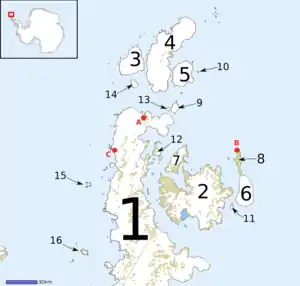
History
The base was established on 18 February 1948 by the Chilean Antarctic Expedition, and is one of the Antarctic bases with the longest times of continuous operation. The winter population is 16, and the peak population in the Antarctic summer is usually 44, although up to 60 persons can be accommodated. The base is operated by the Chilean Army. It is also known as Puerto Covadonga after the port on which it is located.[1]
The German Antarctic Receiving Station (GARS) was established at O'Higgins in 1991 by the DLR. It is a satellite ground station sited in Antarctica to enable reception of data from satellite-based sensors within the south polar region that might otherwise be lost. High bandwidth sensors such as SAR generate too much data to be stored on board the satellite for transmission to ground stations elsewhere. GARS was sited at O'Higgins because of the geology, infrastructure and accessibility of the base.
Three dozen COVID-19 cases were reported on the research base on December 22, 2020. These are the first reported cases on the continent.[2]
Historic site
The O’Higgins Historic Site on Cape Legoupil comprises structures of historical significance:
- The original base was established on 18 February 1948 by the President of the Republic of Chile, Gabriel González Videla, the first head of state in the world to visit Antarctica.
- The Capitán General Bernardo O ́Higgins Riquelme Bust was erected in 1948 opposite the base.
- A plaque was erected on 12 August 1957 in memory of Lieutenants Oscar Inostroza Contreras and Sergio Ponce Torrealba.
- The Virgen del Carmen Grotto, near the base, was built in the early 1970s to serve as a place of spiritual withdrawal for the staff of various Antarctic stations and expeditions.
It was designated a Historic Site or Monument (HSM 37), following a proposal by Chile to the Antarctic Treaty Consultative Meeting.[3]
Climate
Bernardo O'Higgins Base experiences a borderline polar tundra climate (Köppen ET) that is extremely close to a polar ice cap climate (Köppen EF). Average annual precipitation amounts to 771 mm (30.35 in), and is distributed fairly evenly throughout the year, typically peaking marginally during the austral spring. Temperatures are frigid all year-round; the warmest month is January with an average monthly temperature of 1 °C (34 °F), while the coldest month is July with an average monthly temperature of −9 °C (16 °F).
| Climate data for Bernardo O'Higgins Base, elevation: 10 m or 33 ft, (1961–1990 normals, extremes 1953–present) | |||||||||||||
|---|---|---|---|---|---|---|---|---|---|---|---|---|---|
| Month | Jan | Feb | Mar | Apr | May | Jun | Jul | Aug | Sep | Oct | Nov | Dec | Year |
| Record high °C (°F) | 12.0 (53.6) |
10.0 (50.0) |
11.4 (52.5) |
5.0 (41.0) |
11.5 (52.7) |
10.6 (51.1) |
7.0 (44.6) |
12.8 (55.0) |
14.0 (57.2) |
9.2 (48.6) |
9.2 (48.6) |
10.0 (50.0) |
14.0 (57.2) |
| Daily mean °C (°F) | 0.5 (32.9) |
0.1 (32.2) |
−1.4 (29.5) |
−4.1 (24.6) |
−6.3 (20.7) |
−8.0 (17.6) |
−8.5 (16.7) |
−8.4 (16.9) |
−5.6 (21.9) |
−3.5 (25.7) |
−1.7 (28.9) |
0.1 (32.2) |
−3.9 (25.0) |
| Record low °C (°F) | −10.1 (13.8) |
−14.0 (6.8) |
−20.0 (−4.0) |
−25.0 (−13.0) |
−30.0 (−22.0) |
−34.2 (−29.6) |
−34.4 (−29.9) |
−33.2 (−27.8) |
−29.2 (−20.6) |
−26.0 (−14.8) |
−15.0 (5.0) |
−10.6 (12.9) |
−34.4 (−29.9) |
| Average precipitation mm (inches) | 28.9 (1.14) |
64.0 (2.52) |
74.1 (2.92) |
78.0 (3.07) |
66.7 (2.63) |
50.7 (2.00) |
65.5 (2.58) |
67.2 (2.65) |
87.7 (3.45) |
87.1 (3.43) |
61.9 (2.44) |
38.7 (1.52) |
770.5 (30.33) |
| Average relative humidity (%) | 81 | 84 | 83 | 81 | 84 | 82 | 82 | 81 | 82 | 81 | 80 | 81 | 82 |
| Mean monthly sunshine hours | 105 | 83 | 35 | 28 | 18 | 11 | 15 | 29 | 46 | 73 | 92 | 111 | 646 |
| Source 1: NOAA[4] | |||||||||||||
| Source 2: Dirección Meteorológica de Chile (extremes)[5] and Deutscher Wetterdienst (sun)[6][lower-alpha 1] | |||||||||||||
See also
O'Higgins Skiway | |||||||||||
|---|---|---|---|---|---|---|---|---|---|---|---|
| Summary | |||||||||||
| Airport type | Private | ||||||||||
| Location | General Bernardo O'Higgins Riquelme Station | ||||||||||
| Elevation AMSL | 648 ft / 198 m | ||||||||||
| Coordinates | 63°20′34″S 57°49′23″W | ||||||||||
| Map | |||||||||||
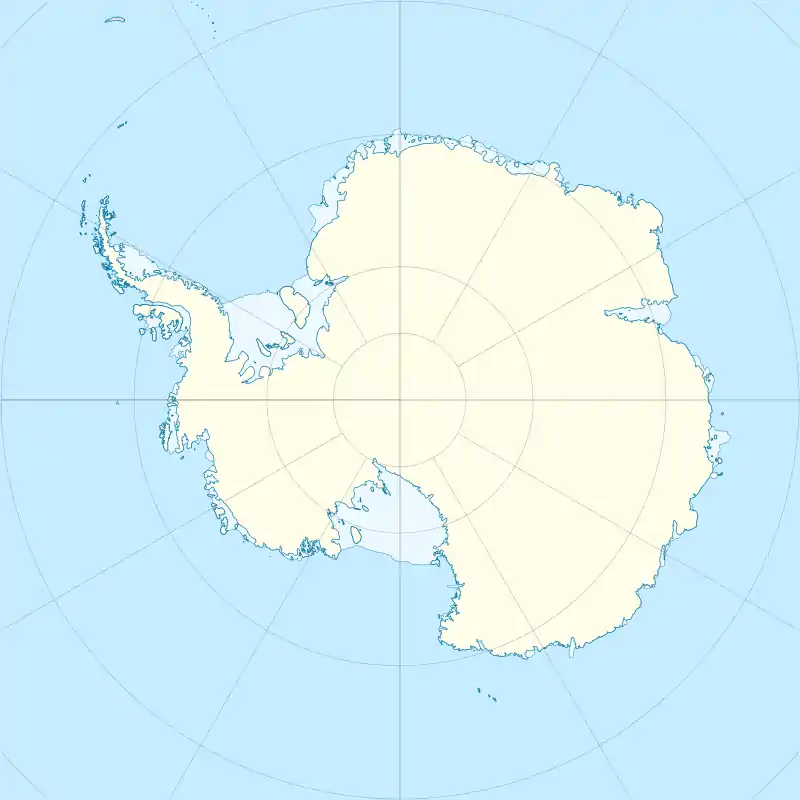 O'Higgins Skiway Location of airfield in Antarctica | |||||||||||
| Runways | |||||||||||
| |||||||||||
Notes
- Station ID for Base Bernardo O'Higgins is 89059 Use this station ID to locate the sunshine duration
References
- "Base General Bernardo O'Higgins" (PDF). Archived from the original (PDF) on 2007-07-15. Retrieved 2008-02-26.
- Lardieri, Alexa (December 22, 2020). "Coronavirus Cases on Chilean Research Base Are First Reported in Antarctica". msn.com. U.S. News and World Report. Retrieved December 22, 2020.
- "List of Historic Sites and Monuments approved by the ATCM (2012)" (PDF). Antarctic Treaty Secretariat. 2012. Retrieved 2013-12-31.
- "Base Antarctica B. O'Hig Climate Normals 1961–1990". National Oceanic and Atmospheric Administration. Retrieved February 19, 2014.
- "Temperatura Mensual Histórica de Bernardo O'Higgins, Base Antártica (950003)". Sistema de Administración de Datos Climatológicos (in Spanish). Dirección Meteorológica de Chile. Archived from the original on June 3, 2016. Retrieved April 23, 2016.
- "Station 89059: Base Bernardo O'Higgins". Global station data 1961–1990—Sunshine Duration. Deutscher Wetterdienst. Archived from the original on 17 October 2017. Retrieved 23 April 2016.
External links
- (in Spanish) Base General Bernardo O'Higgins
- (in Spanish) Official website Instituto Antartico Chileno
- The O'Higgins Penguin Webcam (gentoo penguins; seasonal)
- (in German) Antarktis Station, a personal website about life at GARS O'Higgins.
- COMNAP Antarctic Facilities
- COMNAP Antarctic Facilities Map
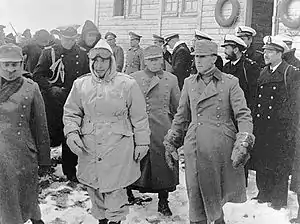

| Wikimedia Commons has media related to Bernardo O'Higgins Station. |
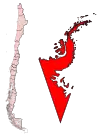
.svg.png.webp)